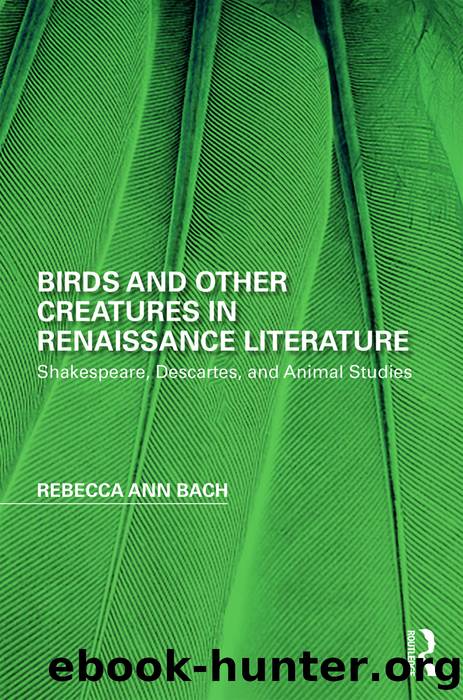Birds and Other Creatures in Renaissance Literature by Rebecca Ann Bach

Author:Rebecca Ann Bach
Language: eng
Format: epub
Publisher: Taylor & Francis (CAM)
Published: 2017-07-20T00:00:00+00:00
Tarquin is depicted here as being like the creatures that, as a noble man, he would employ to huntâhe is like a hawk and like a hound. But rather than controlling those creatures and using their natures to make them serve him as a hunter, he is shown as resembling hunting creatures fed at the wrong time. Once again the poem references âcross-species sociality,â but the referent here is to mistaken human practice. Humans warned each other of the dangers of overfeeding hawks and hounds in training. However, unlike actual hounds and hawks whom humans might mishandle, Tarquin has overfed himself rather than being overfed. Tarquin is not the same as an overfed hawk, but he acts like one, and because he is âsurfet-taking,â he has acted âagainst himselfeâ (717, 698). The overfed hounds and hawks, in contrast, are the victims of humans who make them act against their ânature.â Tarquin compromises his natural community alliance with noble human predators who hunt with birds because he resembles maltreated hunting allies. He is not only like carrion birds; he is like poorly trained hawks and hounds.
The predator/prey divisions in the poem are equally visible and meaningful in three metaphor-filled moments that make Lucrece into a lamb threatened and attacked by wolves and dogs. These appear prior to the rape, describing the rape itself, and describing Tarquinâs exit from the scene. The narrator explains that Tarquin prepares to rape Lucrece in âthe dead of night,â a time in which âNo noise but Owles, & wolues death-boding cries: / Now serues the season that they may surprise / The sillie Lambsâ (165â7). Here, before the rape, Lucrece is associated with harmless, âsillieâ creatures at risk from prey creatures who act under the cover of darkness and whose sounds forecast violent death. The actual rape scene is told through metaphors, but it makes explicit this earlier implicit comparison of Lucrece to a lamb. The extended series of metaphors in which Tarquin is a wolf and Lucrece a lamb cross two stanzas:
ââThe wolfe hath ceazd his pray, the poor lamb cries,
Till with her own white fleece her voice controld,
Intombes her outcrie in her lips sweet fold.
For with the nightlie linnen that shee weares,
He pens her piteous clamors in her head. (677â81)
Download
This site does not store any files on its server. We only index and link to content provided by other sites. Please contact the content providers to delete copyright contents if any and email us, we'll remove relevant links or contents immediately.
Sapiens: A Brief History of Humankind by Yuval Noah Harari(13041)
The Tidewater Tales by John Barth(12026)
Do No Harm Stories of Life, Death and Brain Surgery by Henry Marsh(6333)
Mastermind: How to Think Like Sherlock Holmes by Maria Konnikova(6228)
The Thirst by Nesbo Jo(5779)
Why We Sleep: Unlocking the Power of Sleep and Dreams by Matthew Walker(5637)
Sapiens by Yuval Noah Harari(4531)
Life 3.0: Being Human in the Age of Artificial Intelligence by Tegmark Max(4497)
The Longevity Diet by Valter Longo(4444)
The Rules Do Not Apply by Ariel Levy(3899)
The Immortal Life of Henrietta Lacks by Rebecca Skloot(3821)
The Body: A Guide for Occupants by Bill Bryson(3791)
Why We Sleep by Matthew Walker(3768)
Animal Frequency by Melissa Alvarez(3750)
Yoga Anatomy by Kaminoff Leslie(3697)
Barron's AP Biology by Goldberg M.S. Deborah T(3629)
The Hacking of the American Mind by Robert H. Lustig(3576)
All Creatures Great and Small by James Herriot(3510)
Yoga Anatomy by Leslie Kaminoff & Amy Matthews(3392)
